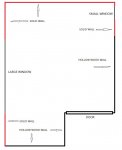As others have posted, the requirements for the various parts of creating a finished recording can actually require some different kinds of room treatment, but for the majority of us doing all this at home in a single, less-than-ideal space, it's a matter of compromising and doing what is appropriate for most of the room's use cases.
Now, that is often mixing, and that is really the bigger challenge because all of the surfaces in the room can contribute to problems in mixing with monitors (vs. headphones). In your case, with your budget, I'd want to first locate your desk and mixing spot where it will be fighting less with the room, and that looks like placing it centrally at the narrow wall at the top of your picture. Then, you treat early reflection points at the sides and overhead and also behind your monitors if they have rear-facing ports. Get heavy drapes for the windows. By building your own treatment panels (lots of examples here and on YouTube videos) you can probably stay within your budget, but not a lot more will be possible, IMO/IME. You'd ideally add bass traps (floor to ceiling, 2x+ deep treatment panels), but just the materials for those are going to chew up some $ unless you can find scraps for free. And, frame building does require access to a miter or table saw for the best results.
For vocal tracking, you will just have to test areas of your room, or possibly resort to tracking in a closet (I've never done this, but I have heard decent results, honestly) so you minimize room reflection. If your narrow end of the room by the desk is well treated for mixing, you might find that it works reasonably well for vocals, too, depending on the singer, mic, and what else is in the room. Diffusion at the back wall is something that will help, and you can accomplish that with bookcases - you might already have some things you can use there. You might be able to simply open the door while tracking if it doesn't add noise in the room that intrudes, since that will remove that reflection point.
Good luck.
P.S. Rockboard and Owens may be hard to source locally and shipping for those materials will just kill your budget. I've been able to find Roxul Safe'n'Sound - a "rock wool" product that is not rigid and slightly thicker (designed for between stud placement inside those "hollow" walls) for the same density, and it works well, at the expense of some additional thickness and it does require framing.


